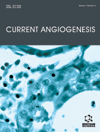-
s Mechanisms of Angiogenesis: Perspectives from Antiangiogenic Tumor Therapies
- Source: Current Angiogenesis (Discontinued), Volume 1, Issue 2, Jun 2012, p. 139 - 147
-
- 01 Jun 2012
Abstract
Growth of solid tumors and cancer metastases is accompanied by inflammation-assisted remodeling of the tissue microenvironment that resembles the physiological process of wound healing. As a consequence, the non-malignant tumor stroma constitutes up to 85% of the tumor volume and is simply not just a passive bystander, but regulates tumor survival, growth and metastatic spread. The importance of the tumor vasculature was first recognized in 1971, when Judah Folkman suggested that neovascularization allows a tumor to exceed its dormant stage and grow beyond a size of 2 mm. This hypothesis was not fully appreciated until three decades later when the outbreak of angiogenesis research was followed by the first clinical applications of antiangiogenic drugs. Even though the antiangiogenesis paradigm is broadly accepted, the clinical success of new drugs is limited. Different mechanisms of resistance to antiangiogenesis treatments have been proposed, like compensatory action of blood vessel growth factors, lower sensitivity of normalized vessels to the therapy or vessel growth by alternative modes of angiogenesis. In this review we will analyze the known mechanisms of neovascularization, including postnatal vasculogenesis, sprouting angiogenesis, intussusceptive angiogenesis, and looping angiogenesis and their potential effects on tumor vascularization. We will also discuss how the current basic knowledge of angiogenic mechanisms translate into limited success of clinical trials utilizing antiangiogenic drugs.


